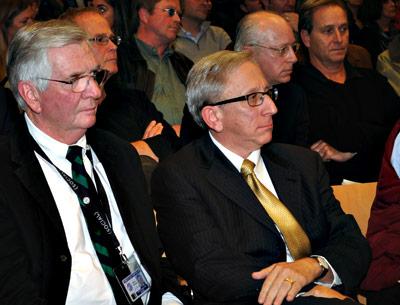F.A.A. $$ May Jeopardize Anti-Noise Bids

Two recent developments on the legal landscape surrounding the East Hampton Airport and Federal Aviation Administration jurisdiction could affect the town’s ability to restrict flights in and out of the airport to control noise and may put greater emphasis on the question of whether the town should continue to accept F.A.A. money, Peter Kirsch, the town’s aviation attorney, told the East Hampton Town Board in a recent memo.
With acceptance of F.A.A. grants comes an obligation to operate the airport according to certain federal “grant assurances,” some of which affect how or if the town can adopt airport use restrictions. Several of those will expire at the end of next year, and airport noise-control advocates assert that the expiration will provide the town with an opportunity to gain more local control.
Others, who point to a need for federal dollars to cover airport maintenance and other expenses, assert that — grant assurances or not — the town is allowed to adopt use restrictions as long as they are “reasonable, nonarbitrary, and nondiscriminatory,” according to federal law.
After several grant assurances expire at the end of 2014, the town’s airport will no longer be subject to the provisions of the federal Airport Noise and Capacity Act.
Both developments, Mr. Kirsch said in his memo, could have an adverse impact on the town’s regulatory authority under the grant assurances and the Airport Noise and Capacity Act.
Under a draft F.A.A. law, many of the helicopters that fly into East Hampton Airport, a primary source of noise complaints, would be put into a new, “Stage 3” aircraft classification, Mr. Kirsch said, explaining that the law is moving forward but that it is unclear when it may be adopted.
Current law allows the town to impose restrictions on helicopters as long as they meet the general federal standards. Under the proposed law, if the town continues to accept F.A.A. money and therefore remains “grant-obligated,” restrictions on Stage 3 helicopters could only be enacted with F.A.A. approval, which Mr. Kirsch calls “unlikely.”
“Given the importance of this potential change and the expiration of certain of the town’s grant obligations in 2014, we believe that we have an obligation to alert the town to the effect of the change even though much remains uncertain at this time,” Mr. Kirsch wrote in his memo to the board.
He also points in his memo to a recent Court of Appeals decision that, he says, “could ease the factual burden on the town to demonstrate that it has a noise problem that justifies a restriction.”
Under the grant assurances, to prove to the F.A.A. the need for an airport use restriction and meet the requirement that rules are “reasonable, nonarbitrary, and nondiscriminatory,” the town must complete a “Part 161” study that documents a noise problem.
Noise, according to the F.A.A., must be measured using a “day-night annual average sound level,” or D.N.L. system, with a 65-decibel threshold standard.
Under that system, however, “it would be difficult for the town to establish the existence of a significant noise problem,” Mr. Kirsch wrote in his memo, as noise above the 65-decibel level is largely contained to the airport property.
In addition, local airport noise-control advocates have said, the sound-level system, in averaging noise over a 24-hour time period, results in an overall average within the F.A.A.’s acceptable parameters, but fails to account for the numerous single acute noise “events” that disturb residents.
In defending a lawsuit last year from a helicopter association challenging the agency’s imposition of a mandatory flight route along Long Island’s north shore, the F.A.A. itself used the prevalence of citizen complaints about noise as a legitimate indicator of a problem, regardless of the sound-level readings. The agency argued, said Mr. Kirsch in his memo, that “ ‘When people take the time to complain about helicopter noise to the F.A.A. and their elected officials, there is a noise problem.’ ”
The court held that citizens’ complaints are “a reasonable and valid basis for determining that there is a significant noise problem.”
Therefore, the aviation attorney advised the town board, “the town may have increased flexibility to establish the significance of a noise problem . . . to establish the need for noise abatement,” provided it is no longer grant-obligated to the F.A.A. and required to comply with the Airport Noise and Capacity Act. The noise standard under that act, said Mr. Kirsch, will still be measured using the averaging system.
While efforts can be made to control noise through airport use restrictions whether the town is obligated to the F.A.A. or not, Mr. Kirsch reiterated in his memo that under the differing scenarios either the town or the F.A.A. would have the primary authority to determine whether airport restrictions are permissible.
That, he said, would significantly change the situation in the event of a lawsuit over the restrictions. “Whether the decision-maker is the town or is the F.A.A. would make a significant difference in the event of a court challenge,” he told the town board in his memo. The courts, he said, “give substantial deference to the decision-maker,” and would “defer to an F.A.A. decision unless it is arbitrary and capricious.”
